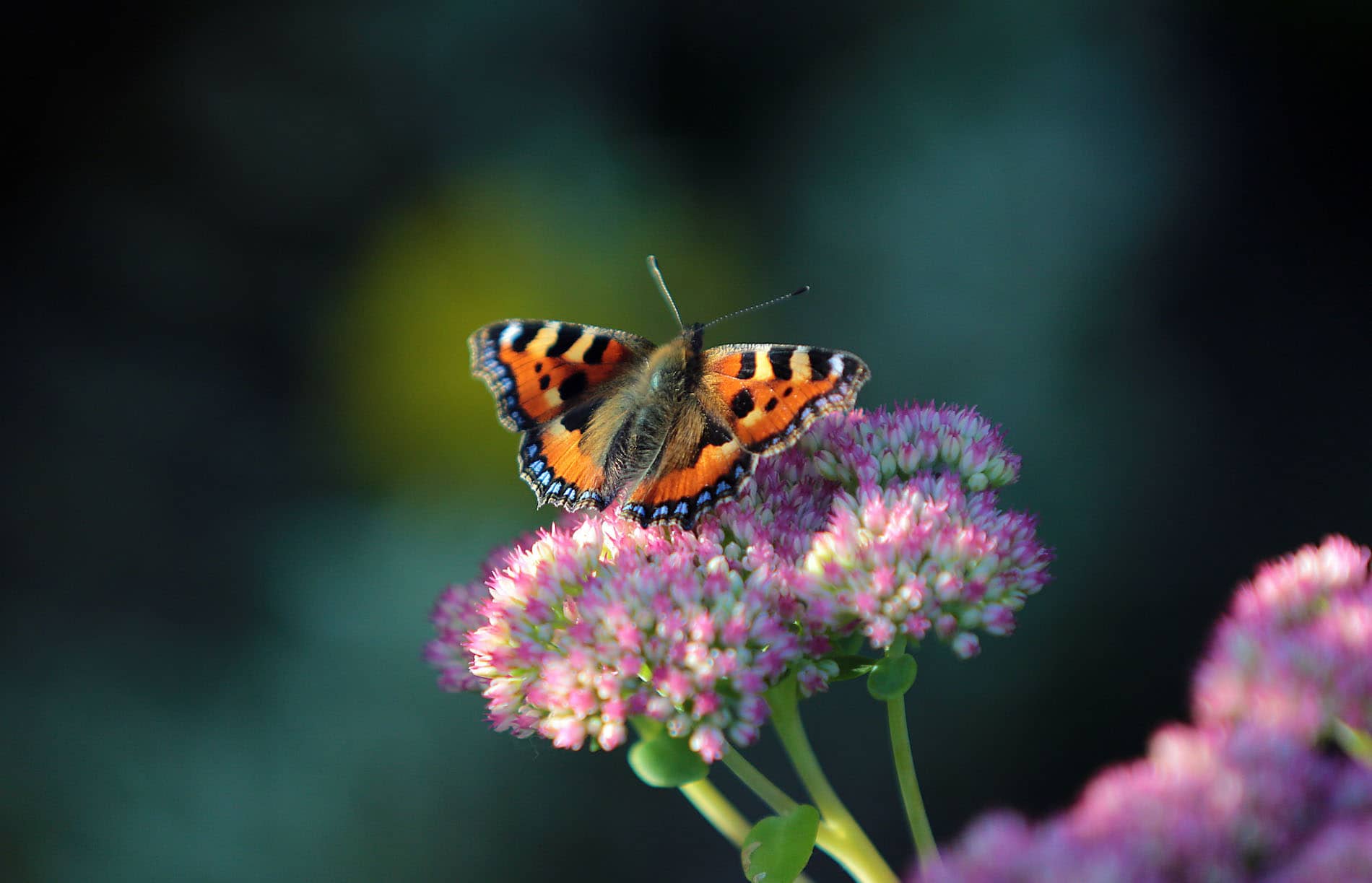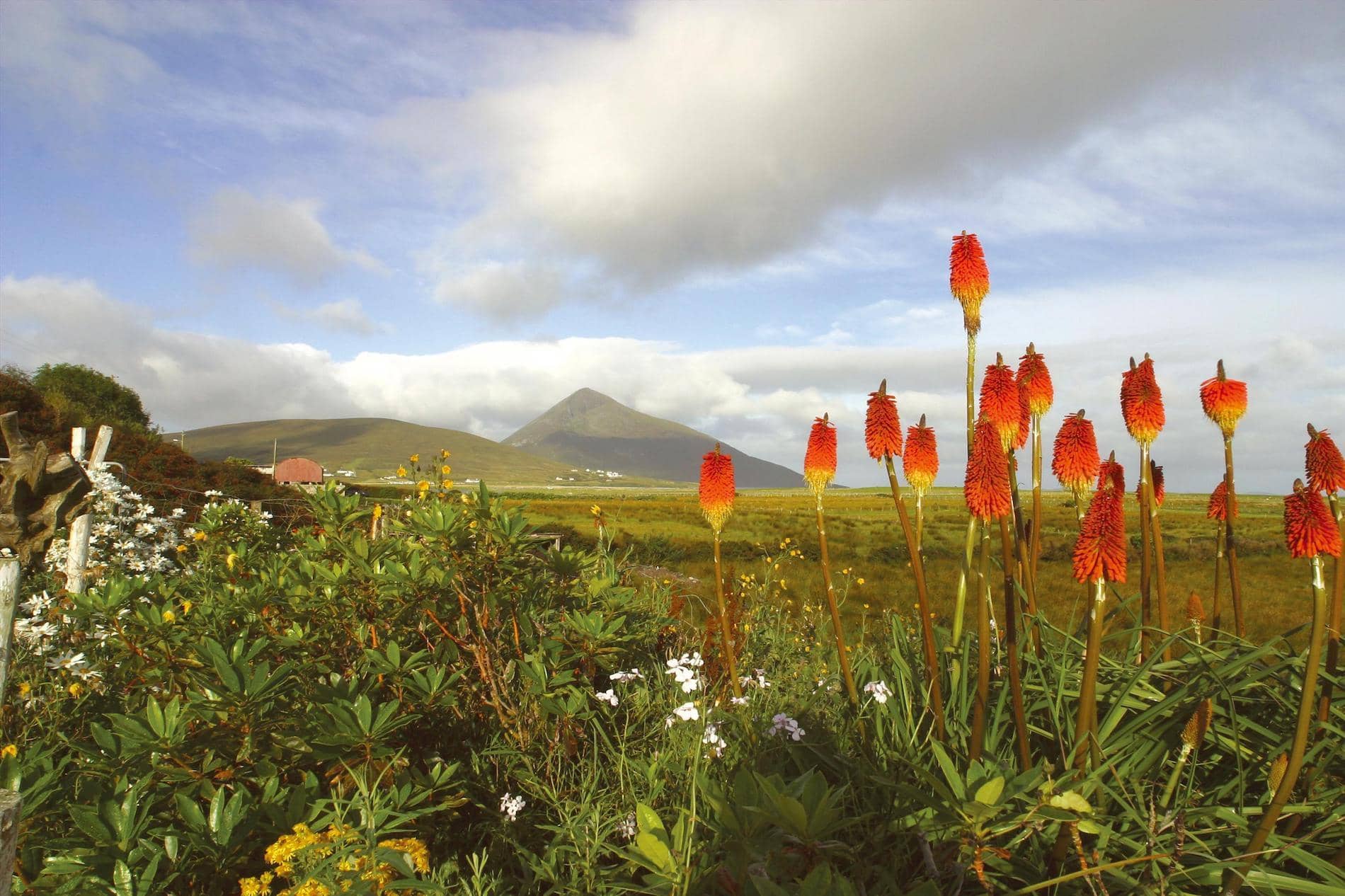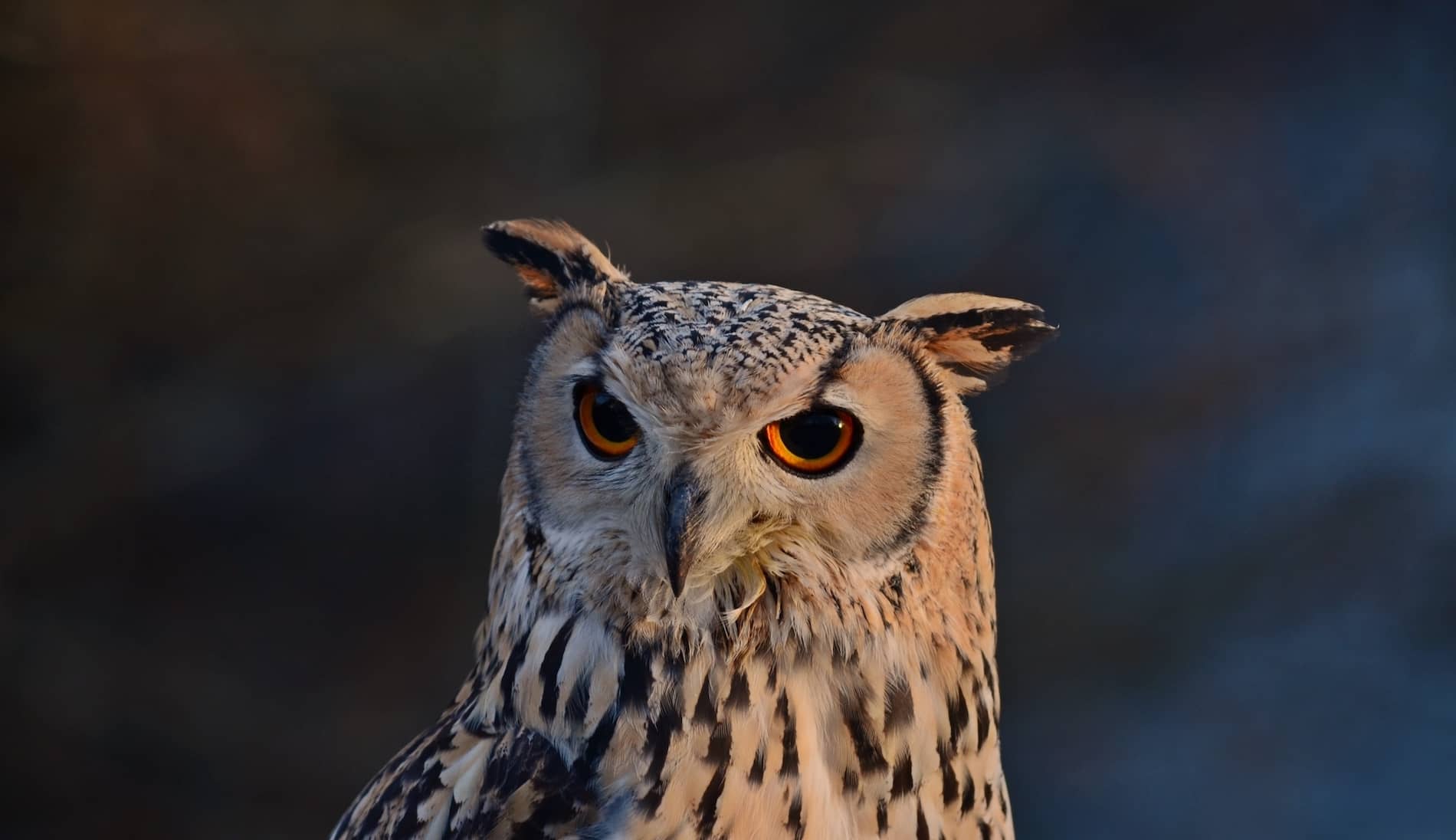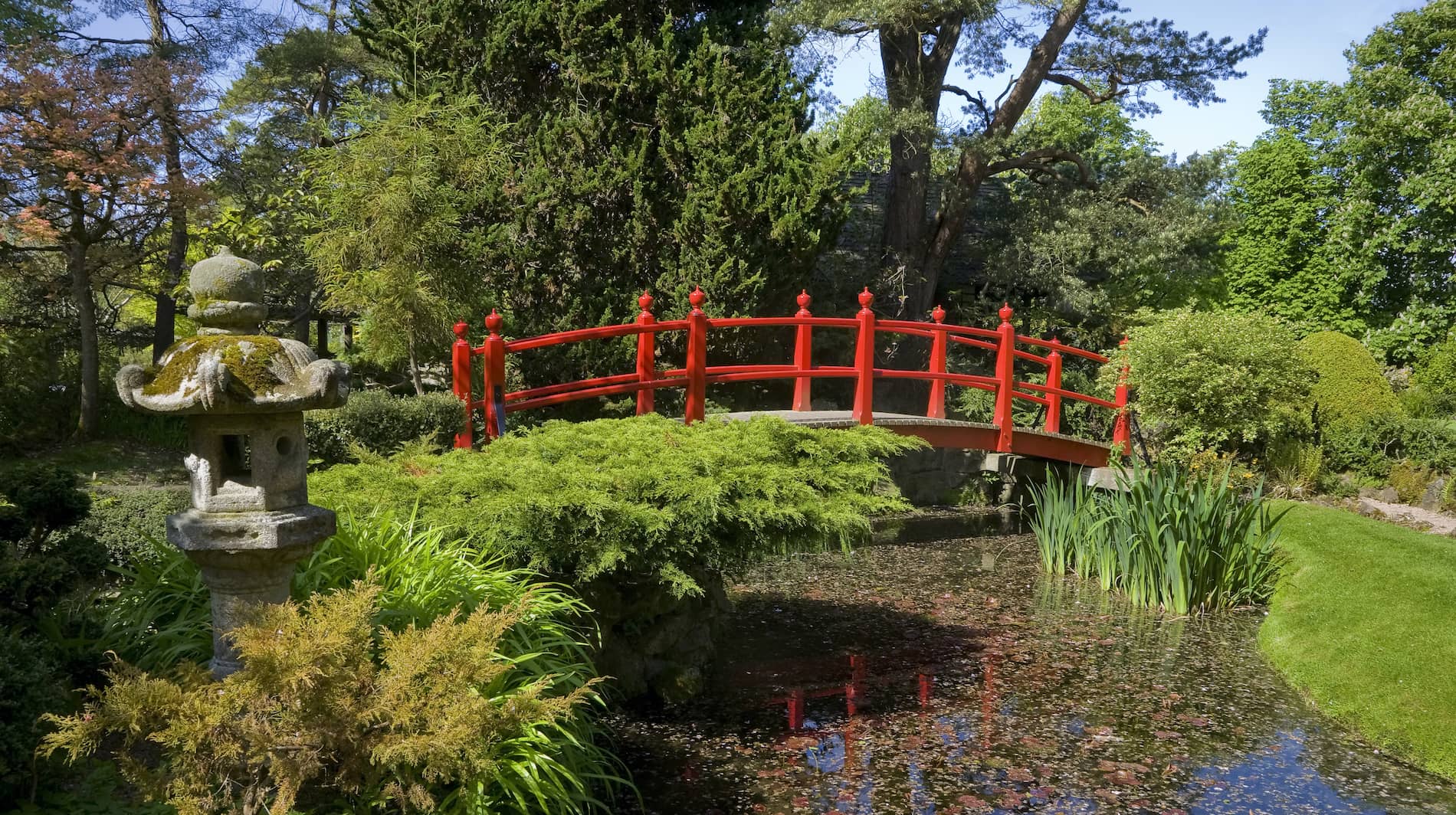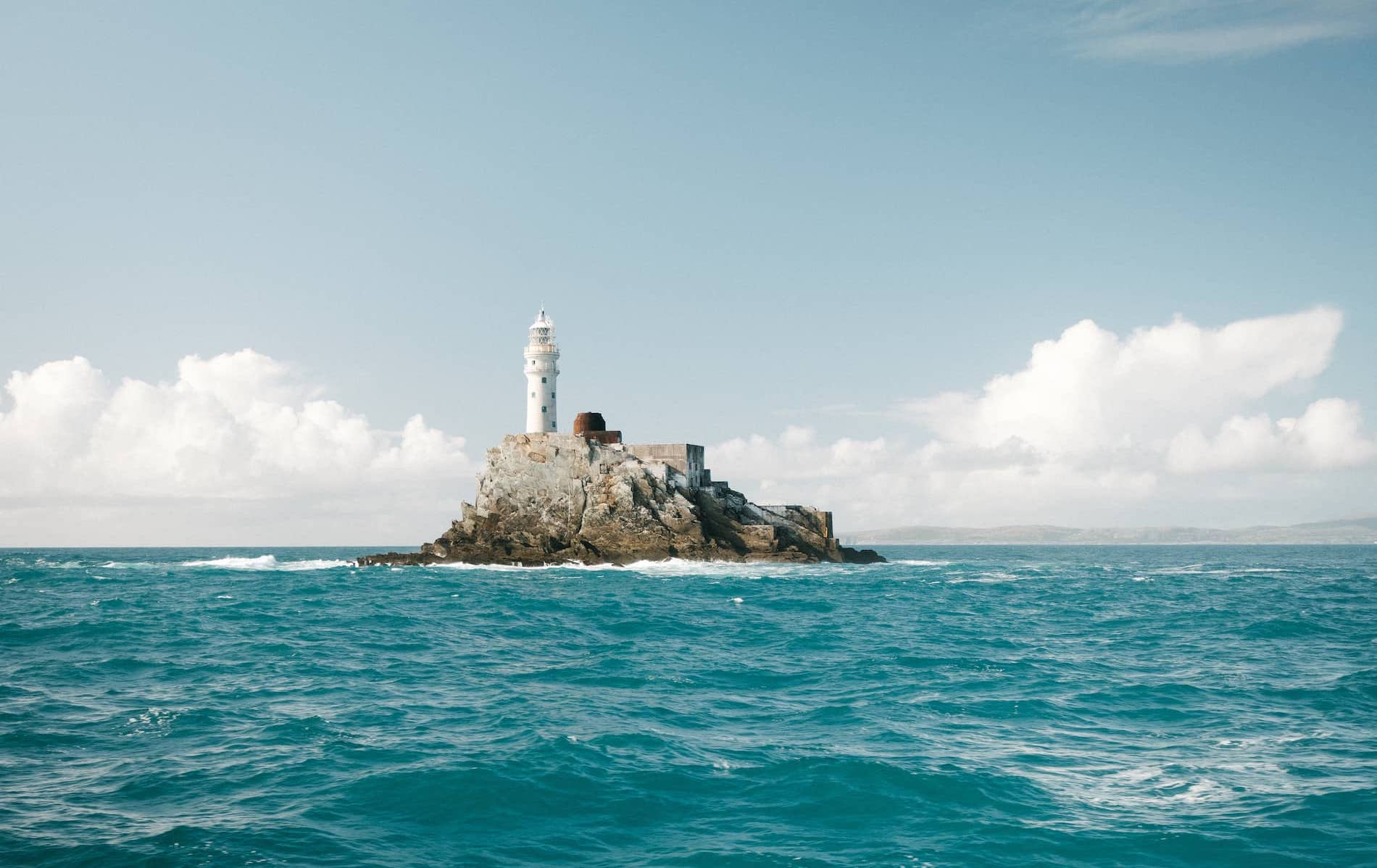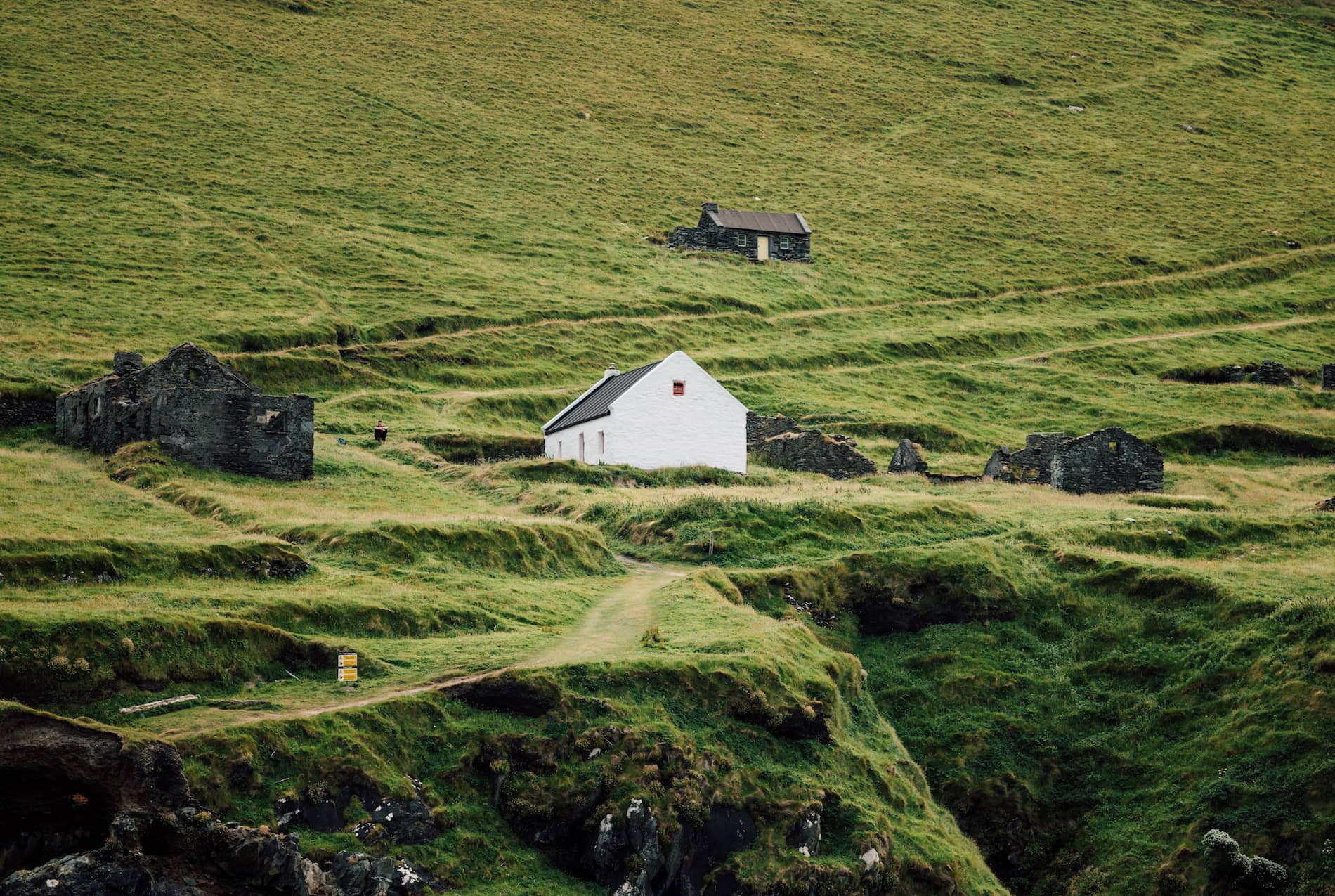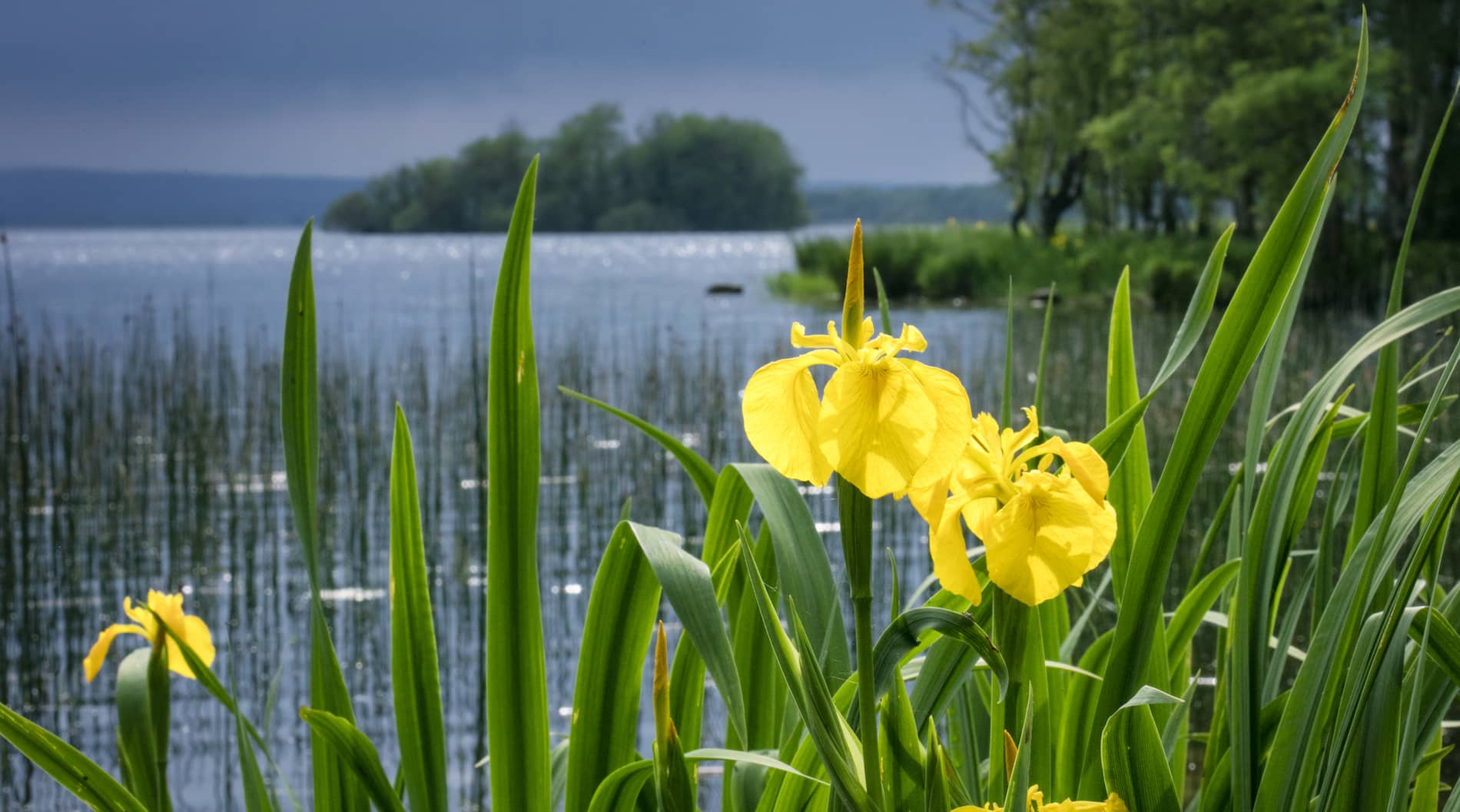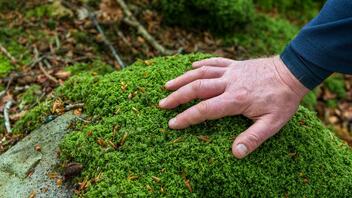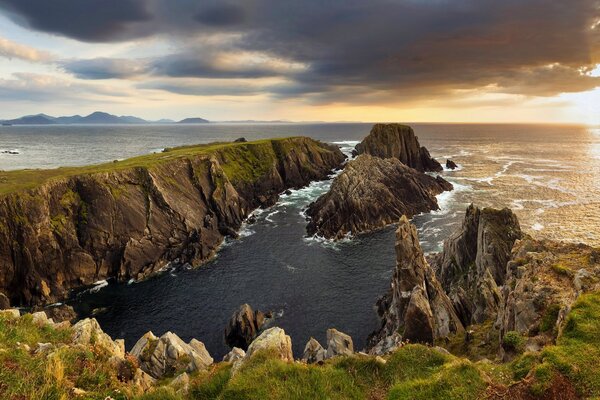
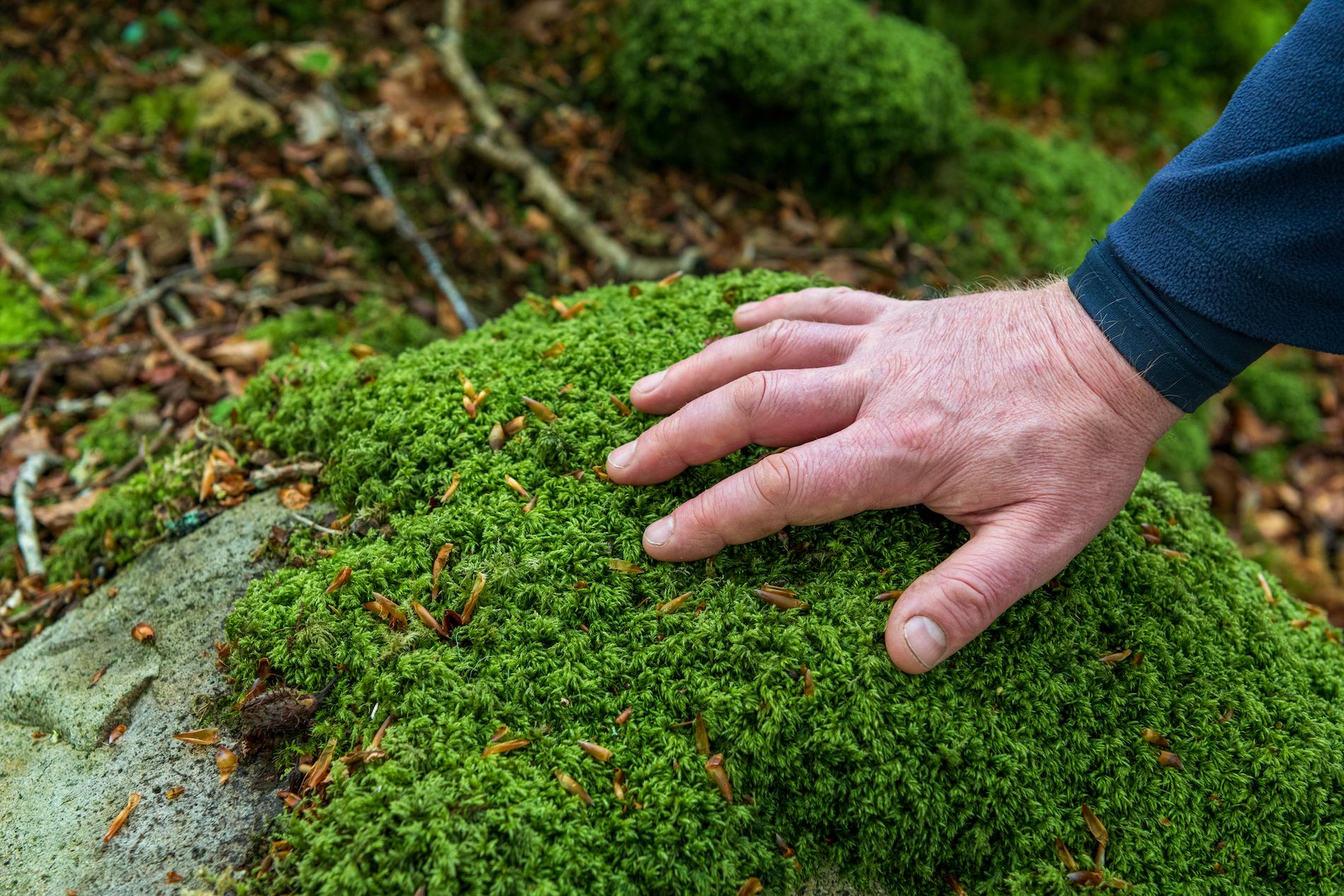
A journey into the forest
It’s intriguing what reveals itself once you start to pay attention.
The potent scent of a handful of just-damp earth scooped from a forest floor, smelling warm and dark with deep spice notes and a hint of something almost sweet.
The curiously soothing effect of running water as it navigates a downhill stream, pooling for rest in quieter corners, picking up pace over a tumble of rocks, reminding us that all life exists in a state of flow from one moment to the next.
The sense of well-being that unfurls with your back against a sun-warm mossy rock, pondering the limbs of trees stretching up to blue and how those grooves of bark look as if etched by a sharp-tongued winter’s wind.

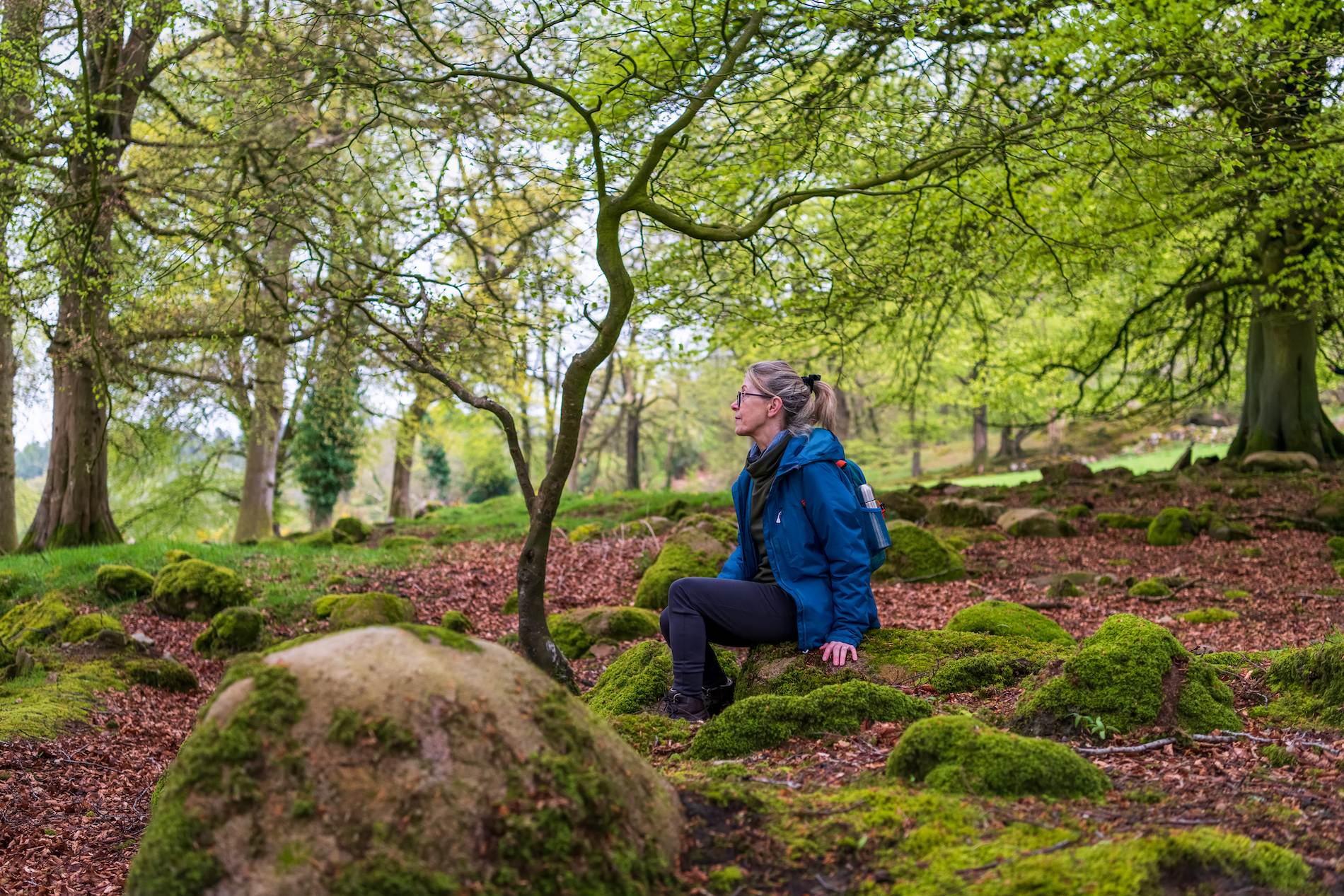
Xhale Meditation at the Ring of Gullion, County Armagh
Today, however, is International Day of Forests (21 March) and spring has positively sprung in this little patch of paradise at the foot of the Slieve Gullion mountains in the south of County Armagh.
I’m deep in the heart of Killeavy Castle Estate’s 350 acres, in the grounding company of Ann Ward, a calm-spirited local guide and accredited practitioner of shinrin-yoku, or “forest bathing”.
Now enjoyed all over the world, this practice was developed in 1980s Japan as a therapeutic response to increasing stress levels that were attributed to the disconnect from nature experienced by a rapidly urbanised and tech-focused society.

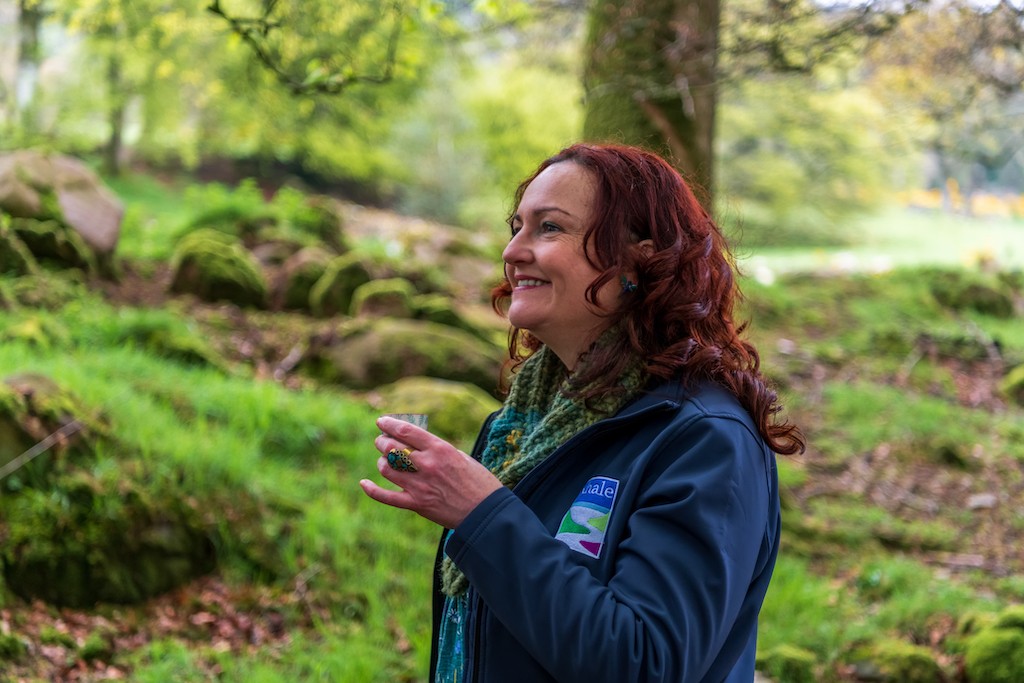
Forest bathing at the Ring of Gullion, County Armagh
Soaking up the goodness of forestsForest bathing can be thought of as like sun bathing, only instead of soaking up those rays and their health-boosting vitamin D, you are soaking up the immune-boosting benefits of living plants within the terrestrial landscape.
And yes, you get to keep your clothes on. Indeed, Ann has advised me to come wearing layers, so I’m cosy and snug within all this beauty.
Scientific studies have found that just two hours of mindful immersion in a forest setting can have measurable immune-boosting effects for up to 10 days, while the positive effect of a full day’s immersion can last for a month.
The experience has also been shown to boost our mood and energy as well as nurturing our creativity and problem-solving ability. Other evidence-based benefits include lowering levels of the stress hormone, cortisol; reducing blood pressure and blood sugar levels; and improving pain thresholds, concentration, memory and overall mental health.
Into the woods
L-R: Finn Lough, County Fermanagh; fungi at Courtown Woods, County Wexford; Glengariff Nature Reserve, County Cork
Forest bathing can be as unstructured as simply taking pause to notice the beauty around you. Key to this practice of mindful embodied immersion in nature is being fully present to consciously experience your surroundings. This can be done as a solo activity: just outside Belfast, for example, under the towering beech trees at Minnowburn woodlands, local authorities have installed free-to-use forest bathing beds on which to lie down, look up and see the world afresh.
Or it might be approached as a shared experience, perhaps staying within the forest itself in magical accommodation such as Finn Lough’s giddily novel geodesic domes and immersive woodland spa in County Fermanagh, or Cabu By The Lakes’s rustic-chic cabins in Killykeen Forest Park in County Cavan.
Alternatively, you can opt for a more structured approach to shinrin-yoku, typically in a two-hour guided sensory immersion. These guided experiences crop up in special spots across the island of Ireland, from the mighty sessile oak forests of Glengarrif Nature Reserve in west Cork to County Wexford’s Courtown Woods.

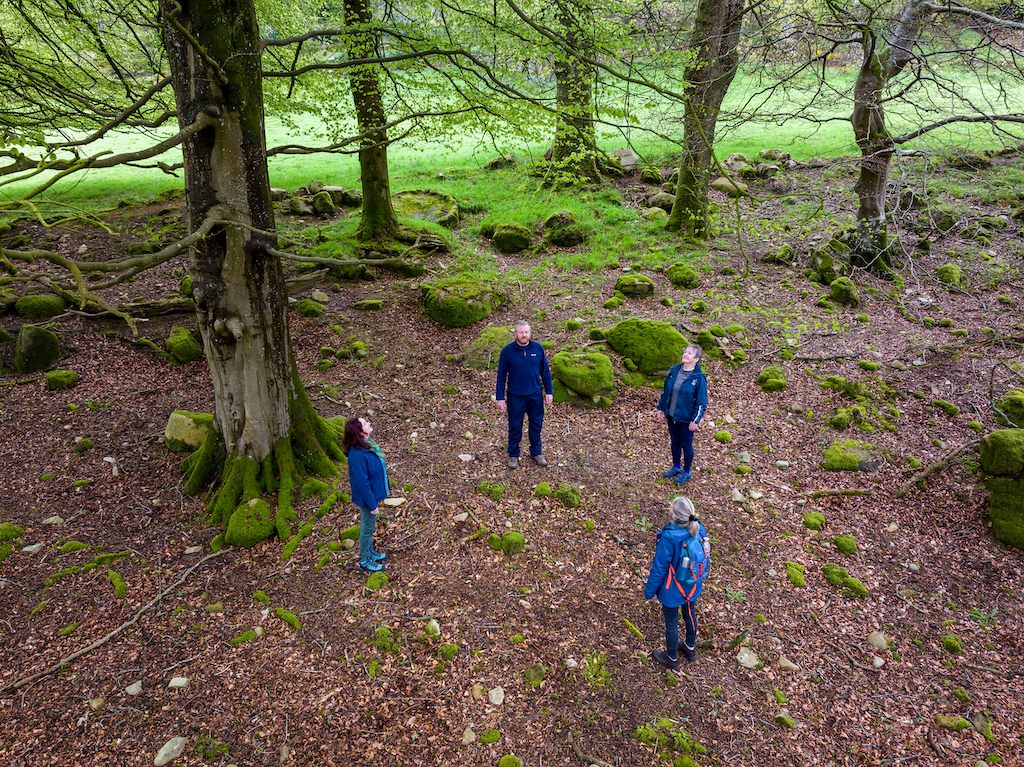
Xhale Meditation at the Ring of Gullion, County Armagh
Part of the beauty of having an experienced practitioner as a guide is that you can leave all rational left-brain thinking and planning to them, and respond to their various ritual “invitations” with your intuitive right brain.
One of several such invitations that Ann makes to me during our south Armagh session is to take some time to properly listen to the forest. “Isn’t it great,” she remarks, “to have nothing else to do else to do but pay attention to your breath and listen to the sounds around you.” Indeed, it’s a rare luxury in our always-on world, albeit one that we could all easily adapt into a regular cost-free personal practice.
As my mind quietens, the soundscape opens up. That wind is there, but today it speaks in soft springtime tones. It rustles through nearby branches, carrying from afar the intermittent beat of a farmer making the most of the fine weather.
Nearby a cow yawns an occasional moan; from farther away comes the muffled bark of a small dog with big things to say. Above it the joyous call and chatter of native birdsong, interspersed with the plaintive mewl of the peacocks that patrol this estate. And at the centre of it all, my own steady breath – light and easy – reminding me that it is good to be alive, and to be in this moment.
Return to nature
L-R: Bluebells in Slieve Gullion forest; Forest Bathing, Ring of Gullion, County Armagh; awakening your senses with Xhale, County Armagh; Wood annemone
In principle, forest bathing can happen anywhere that you can immerse yourself in natural beauty, although research has shown that the high levels of phytoncides produced by trees in particular have an anti-microbial effect on our bodies that helps to boost our immune system.
For Ann, however, this isn’t just anywhere. There is an intimacy to the landscape that she is sharing with me today: in both her personal connections with it and what she describes as its inherent “hug in a landscape” quality.
Time turns elastic as she recounts stories of idyllic childhood days visiting family in mountain cottages like the one where her mother was born; of hand-painting freshly laid eggs to roll down the hill in an Eastertime ritual; or of tending the hearth’s fire with the old fan bellows like generations before her.
Ann’s own spiritual and familial connection to Slieve Gullion’s woodlands is infused with older stories of this mountain’s women and men too.

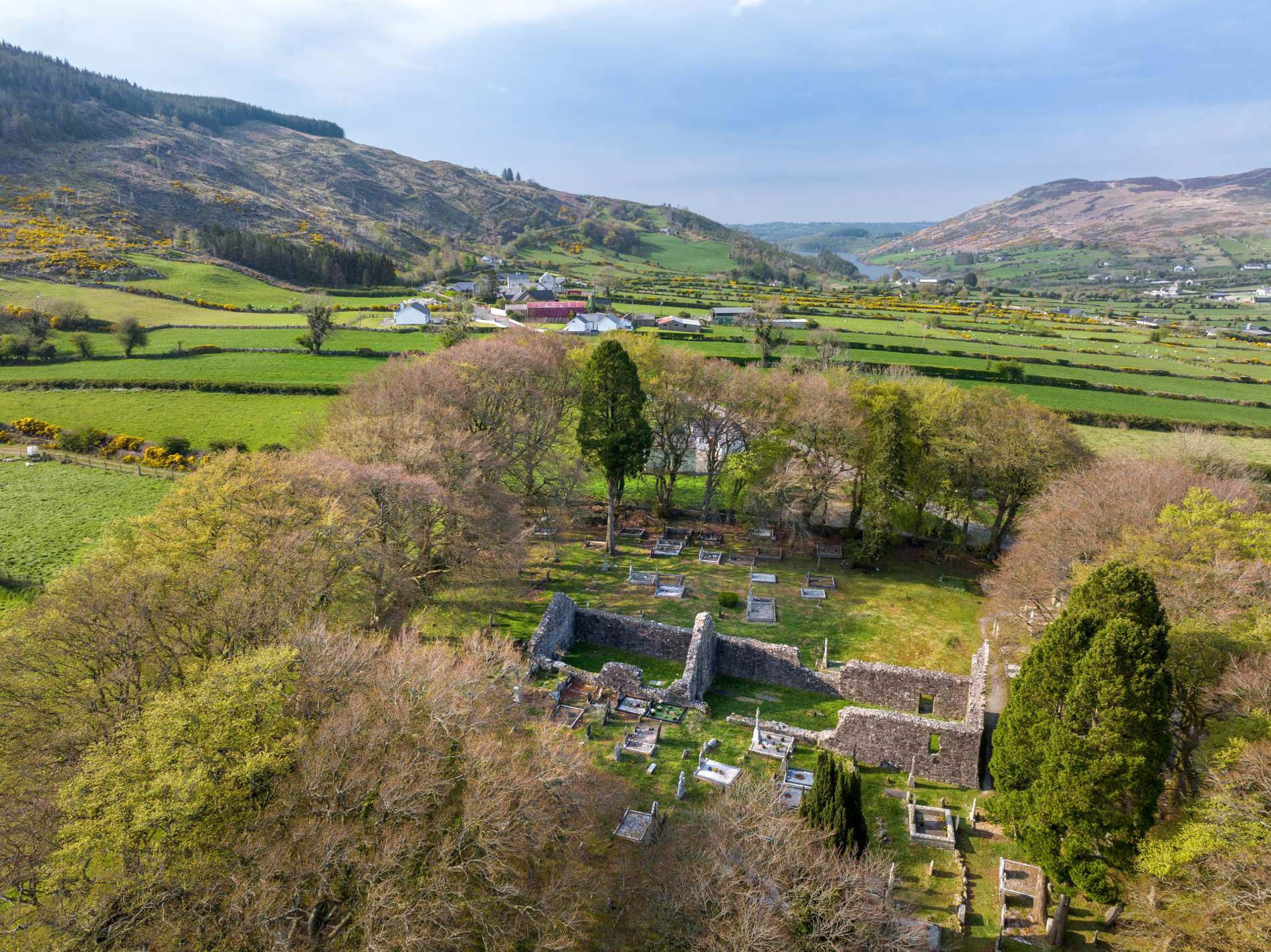
Killeavy Old Churches, County Armagh
Nearby a beech-lined graveyard and the ruins of two small back-to-back churches marks the site known as Killeavy Old Churches. It was here that St Moninna established an important convent in the late 5th century, settling “in a wooded area, lonely except for pigs and wolves, below the mountain”, as one 9th century martyrology text records.
Local yore still tells of a famous miracle that mysteriously transported a huge wooden beam down from the mountain-top for the fourth abbess, Derlaisre, to use as a ridge-piece for the then-wooden church. The convent survived an eventful millennium with 10th century Viking plunders and 12th century deadly winds before being dissolved in 1542 by Thomas Cromwell on behalf of Henry VIII.

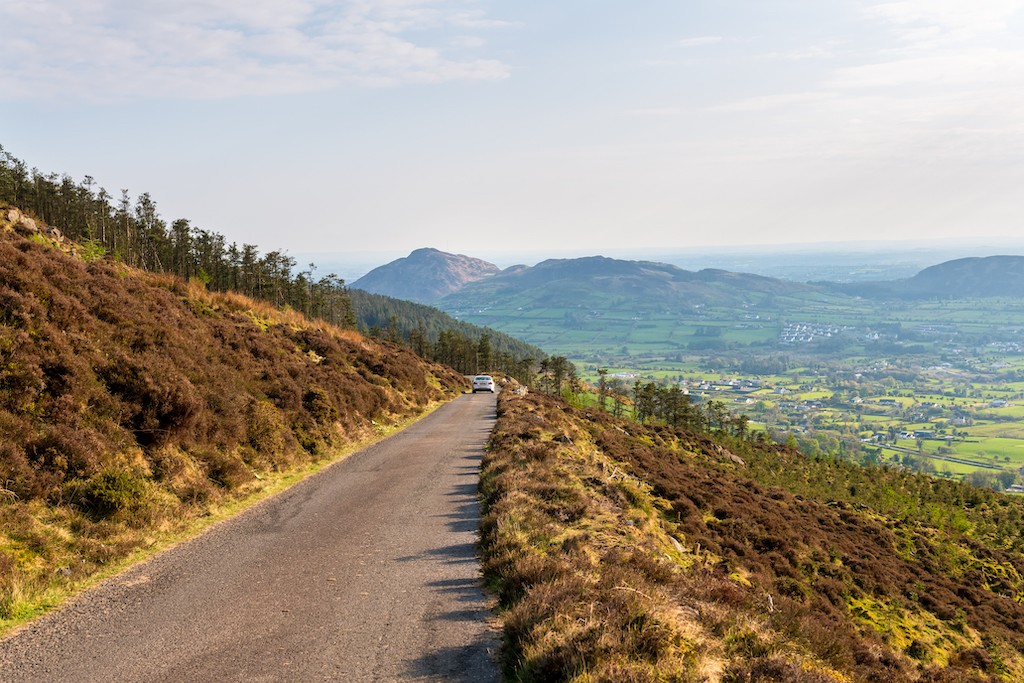
Slieve Gullion, County Armagh
Other local stories here go back beyond history into the realm of myth; after all, this area is the home of two of Irish mythology’s legendary warriors, Fionn MacCumhaill of the Fenian Cycle and Cú Chulainn of the Ulster Cycle. Take a spin through the tall evergreens of the Slieve Gullion Forest Park Drive, up past the Giant’s Lair Children’s Story Trail and Slieve Gullion Adventure Playpark, and walk the last stretch to the summit, and you will find Ireland’s highest surviving Stone Age passage tomb.
Aligned to the setting sun on the winter solstice, which lights up its back chamber, it is also known locally as the house of the mythic trickster Cailleach Beara. Nearby is the magical lake into which they say this feared and revered female figure tempted a young Fionn MacCumhaill for a swim, only for him to emerge as an old man. Though he later shook off her spell, his trademark mane of hair stayed a shock of white for his remaining days.


Slieve Gullion Passage Tomb, County Armagh
This land has drama that even predates the arrival of humans here. From the top of Slieve Gullion, which is the remnant of a volcano last active around 60 million years ago, you can see how this landscape was formed by ice as well as fire.
The surrounding “ring dyke” hills were created where molten-rock magma once bubbled up at various fractures of the encircling ring fault line; later, the passing glaciers of successive ice ages helped to erode deep valleys within what is now the Ring of Gullion.

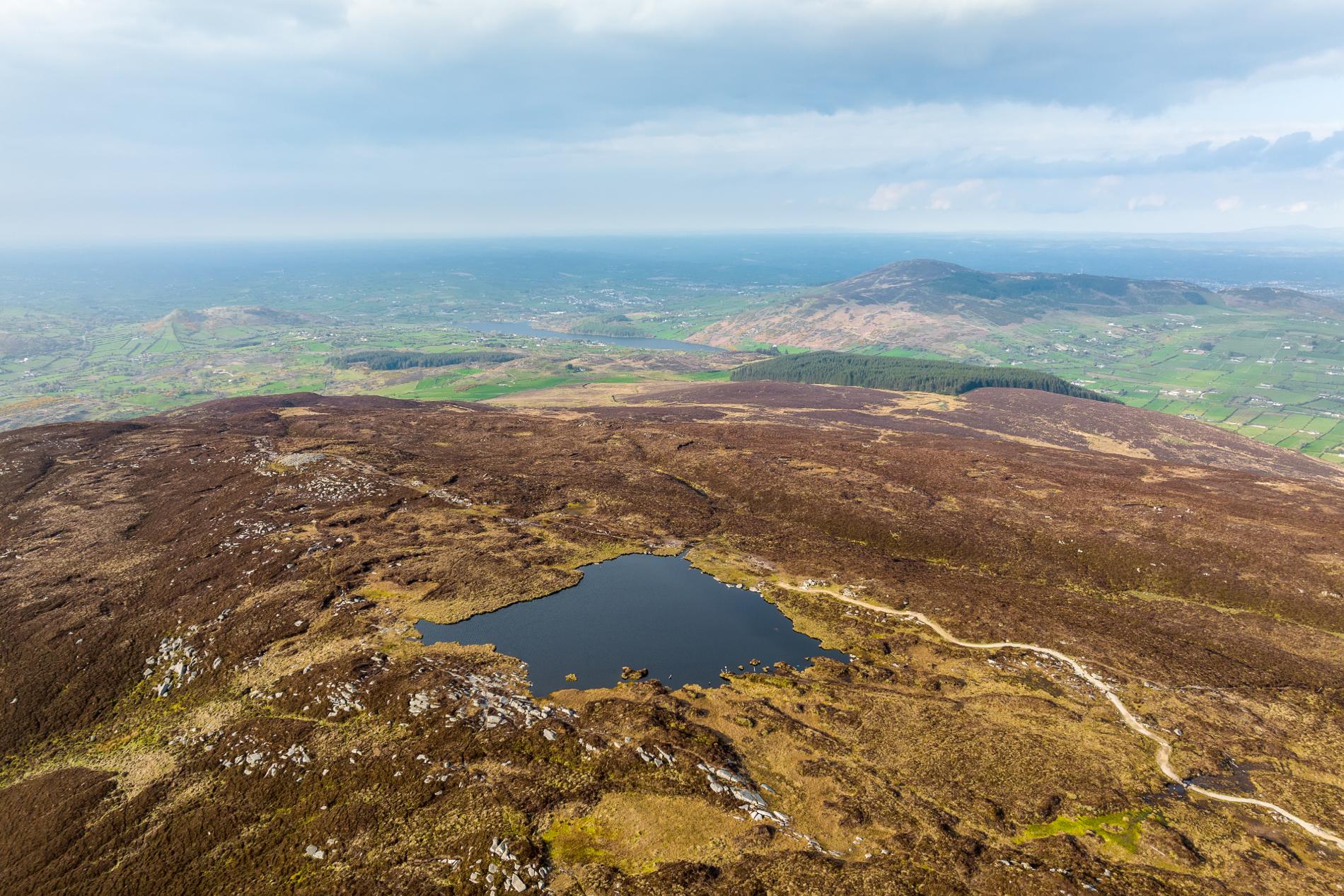
Calliagh Berra's Lake, Slieve Gullion, County Armagh
Later again these hills became home to the native woodlands that once covered most of Ireland in thickly knit temperate rainforest, earning its ancient name of “Inis na bhFiodhbhad” or “woody island” (as I learned from the beautiful volume of photographs and text, Under Summer Pastures: Explorations and Essays from Ireland’s Temperate Rainforests, published by Hometree).
The incremental deforestation of the island began with clearance for farming by Stone Age man as far back as 6,000 years ago.
Though the northeast was one of the last corners on the island to be deforested, the 17th century Plantation of Ulster transformed most remaining forests here into highly valued timber for shipping and roofing.
Pockets of native woodlands and temperate rainforests do survive, in Ulster as elsewhere around the island, alongside trees introduced by newcomers such as the Anglo-Normans who brought their beech trees, and the recent evergreen forests of sitka spruce.

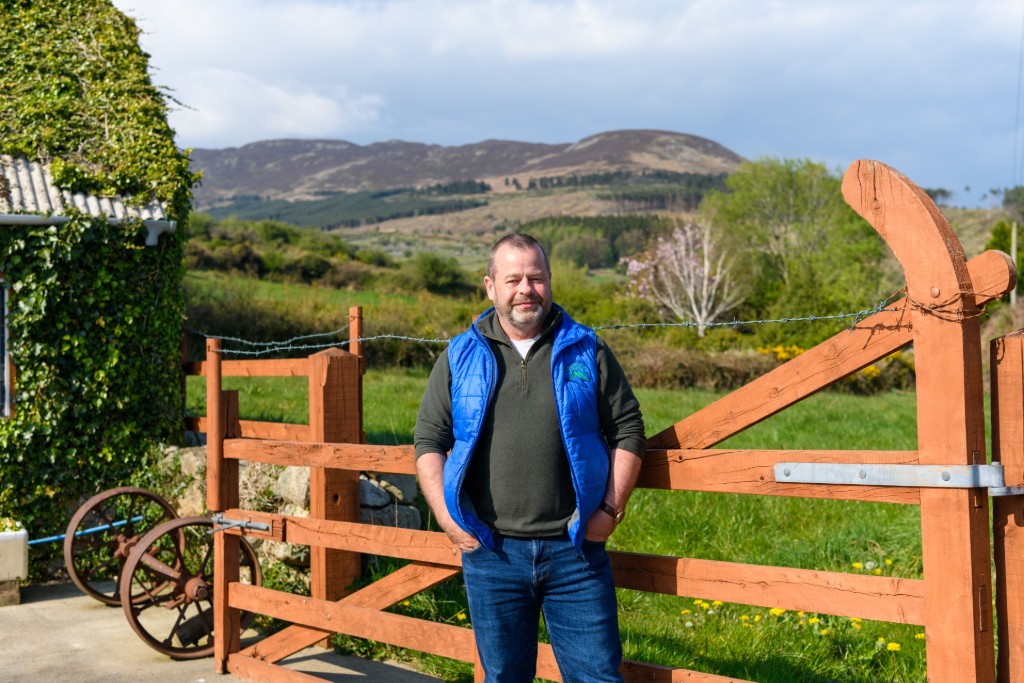
Brian Hooey, Mountain Ways Ireland, County Armagh
The memory of those ancient woods lives on in the landscape in subtler ways too, as the local historian, mountain leader and foraging guide Brian Hoey of Mountain Ways Ireland tells me. Brian knows the Ring of Gullion intimately, and can read the land’s secrets well.
Pre-Plantation, he says, “the great ‘wood of the fuse’ here was so heavily forested that it’s said that a squirrel could run [almost 30km] from Crossmaglen to Newry and never touch the ground. But even in areas that today only have a light tree cover of mountain ash, holly, blackthorn and whitethorn, there’s still some of the ancient indicator species like wood anemone and wood sorrel growing, and carpets of bluebells.”
These linger like a fragrant memory of the native woodlands to which they once belonged.
Peace and relaxation
L-R: Killeavy Castle Estate, County Armagh; Portrait of Jeanette Keenan, basket weaver; Bluebell Lane, County Armagh; bluebells in the countryside
Happily, there are local projects fostering a future for these native woodlands as well as shining a light on their past. Killeavy Castle Estate’s extensive sustainability programme pledges to add to existing oak and birch to develop what will be one of the largest privately owned expanses of broadleaf forests in Ireland and the UK. Meanwhile down in the nearby valley floor, at Bluebell Lane Glamping in Mullaghbawn, woodturner Padraig Carragher is rewilding 26 acres of agricultural land.
Padraig has planted over 20,000 native trees including alder, hazel, mountain ash, birch and oak. Guests to Bluebell Lane’s glamping site or its various cultural and crafts experiences can meander a trail through these five-year-old saplings. Dotted amongst them are age-gnarled solitary hawthorns, revered in Irish tradition as fairy trees and associated with stories of changeling children, and freshly built ponds already humming with life.
Sally gardens of willow are being grown for local basket weaver Jeanette Keenan, who helped Padraig with their lockdown-project build of an Iron Age-style house complete with oak uprights, hazel lats, ash roof trusses and woven willow walls, beneath a thatched reed roof.

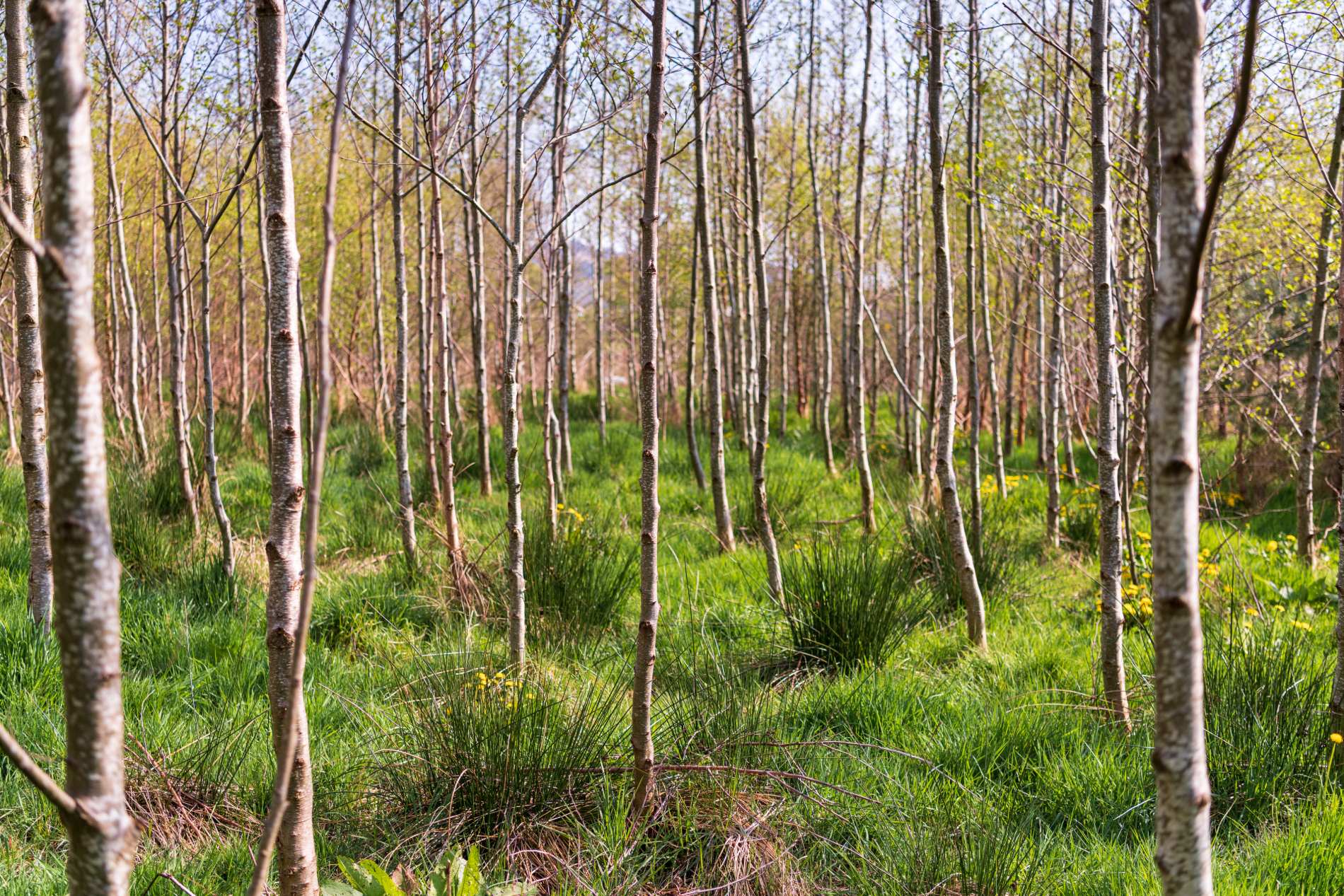
Rewilding at Bluebell Lane, Ring of Gullion, County Armagh
The rewilding offers what Padraig describes as “an invitation for birds to come back to the area,” while the glamping accommodation of shepherd’s huts and safari tents invites visitors “to escape the washing machine of life and be in the moment with one thing”. In other words, it’s a perfect place to get into a forest-bathing state of mind.
Padraig also hosts a hands-on Celtic woodturning visitor experience in his studio with its views of Slieve Gullion. Guests craft a Celtic amulet from a pendant of native wood that they etch with the symbol of their birth month, written in the ancient Irish script of Ogham.
“We’re going back to the Celtic Druid times, when they would have worshipped the stars and the sun and the moon,” he explains. “In the Celtic calendar, they have 13 months for the 13 lunar cycles and each of those months is related back to a native tree.”

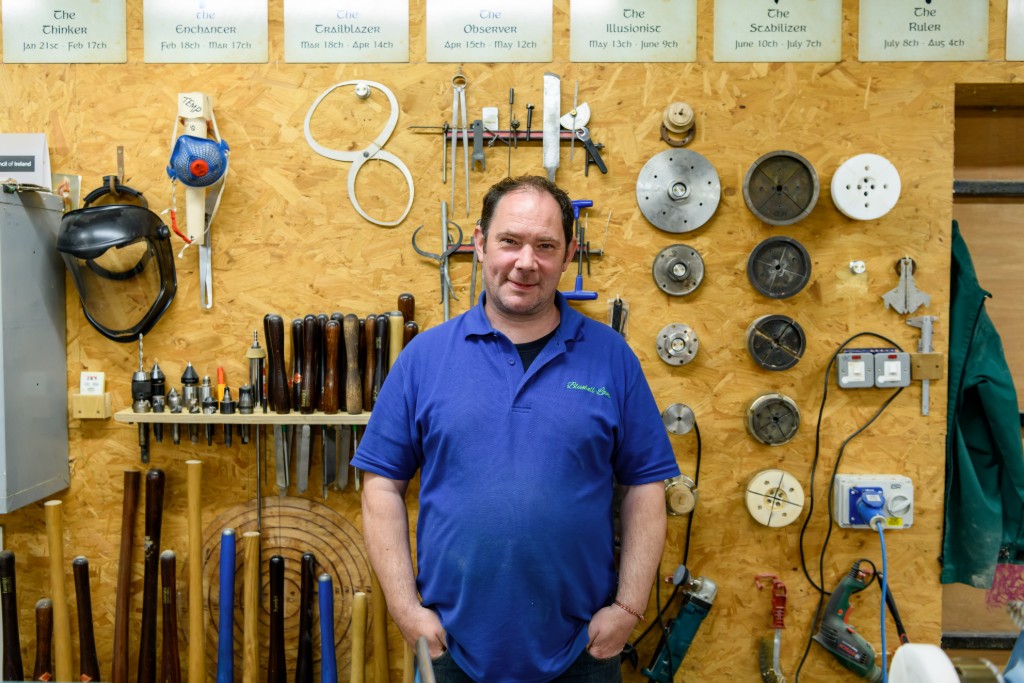
Wood turner Padraig Carragher, Bluebell Lane, County Armagh
Each tree has its own Ogham lettering, and its own symbolic resonance. “Birch means the beginning, or birth, so that’s at the beginning of the calendar… and at the very end it’s elder, symbolising the all-knowing elder man.”
Several trees are associated with protection: ash was used to make spears and arrows, and alder to make protective shields, while rowan or mountain ash was used for spiritual protection. Hazel is strongly associated with wisdom: Fionn MacCumhaill famously ate the Salmon of Knowledge that itself had eaten a hazelnut from the Well of Wisdom, and which gave him the wisdom he needed to rise to leader of the Fianna warriors.

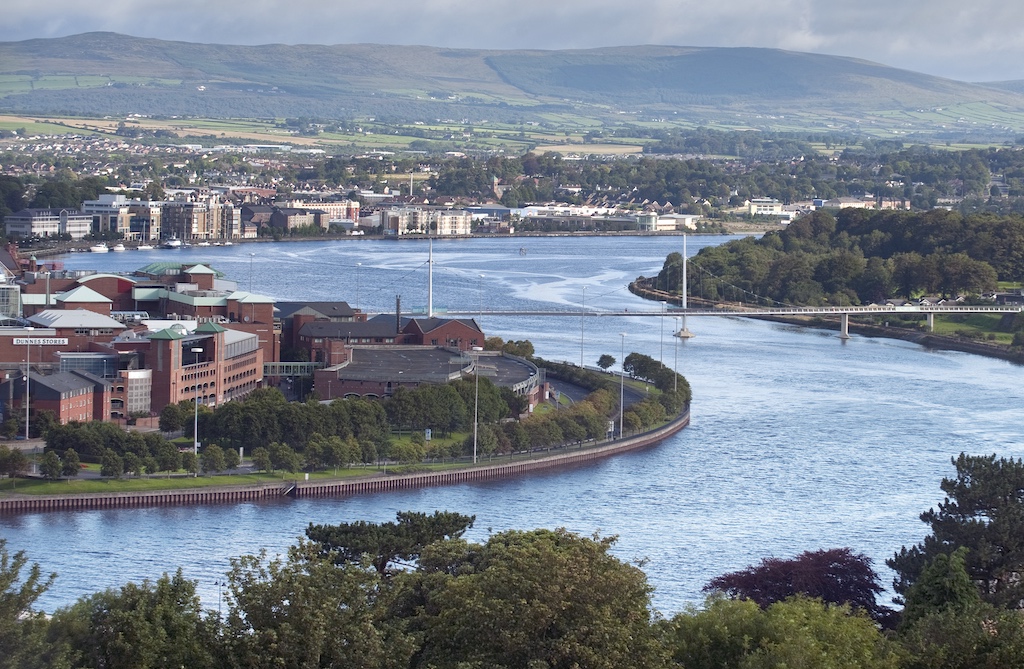
The River Foyle running through Derry~Londonderry
Celtic culture revered all these trees but none more so than the mighty and long-lived oak, which was considered the king of the forest – or the temperate rainforest as much of it once was.
That reverence was harnessed by early Christians in Ireland, where several Christian sites are strongly associated with the oak forest. Kildare where St Brigid founded her abbey takes its name from Cill Dara, meaning “church of oak”, for example, while the city of Derry~Londonderry takes its name from Doire Cholmcille, or ‘Oak wood of Colmcille’, after another of the patron saints of Ireland. St Colmcille – one of Ireland's patron saints along with St Patrick and St Brigid – established his monastery in 542 AD, building it right in the middle of an oak grove, where the druids would have worshipped.
As tour guide David Douglas of Derrie Danders Tours explains: “He would have done this for political reasons. People worshipped trees at the time, so he established his monastery there to say ‘this is the new way’.”
Take to the trails
L-R: A group takes the trail; woodland fungi Foyle Trails, Derry~Londonderry; Martin Bradley of Foyle Trails
Derry~Londonderry original oak groves have long since been harnessed for their valuable wood, and the oaks you’ll find in its parks today are babies in terms of the lifespan of these great trees. Visitors who want to get up close and personal with Ireland’s temperate rainforests can join Derry-based paleo-ecologist and tour guide, Martin Bradley of Foyle Trails, for guided landscape and habitat tours in the north-west.
For his Mythology and Ecology of a Celtic Rainforest experience, Martin heads into neighbouring County Tyrone to reveal to visitors the rich folklore and mythology that developed around Celtic trees and plant species. He has nuggets of knowledge about everything from fairy trees and holy wells to the scarlet elf cup fungi that grow on rotting wood or ivy’s strong connections with All Soul’s Day.
Irish forests and woodlands still serve as fascinating and diverse portals to the past. Many shelter crumbling ruins and settlement remains going back centuries and even millenia. In Courtown Woods the 5th century Highcross of Kilbride sits amongst ancient woodlands co-existing with the beech groves, chestnut walks and Californian redwoods planted in the 19th century by the 5th Earl Stopford.
In County Fermanagh’s Cuilcagh Lakelands Geopark, Lough Navar Forest overlooks the lake’s remains of a “crannog”, or Bronze Age manmade island farmstead. Amongst 520 hectares of broadleaf and coniferous trees edging Lower Lough Erne, in Castle Archdale Forest you can explore a 17th century fortification and key World War II flying boat docks and buildings.

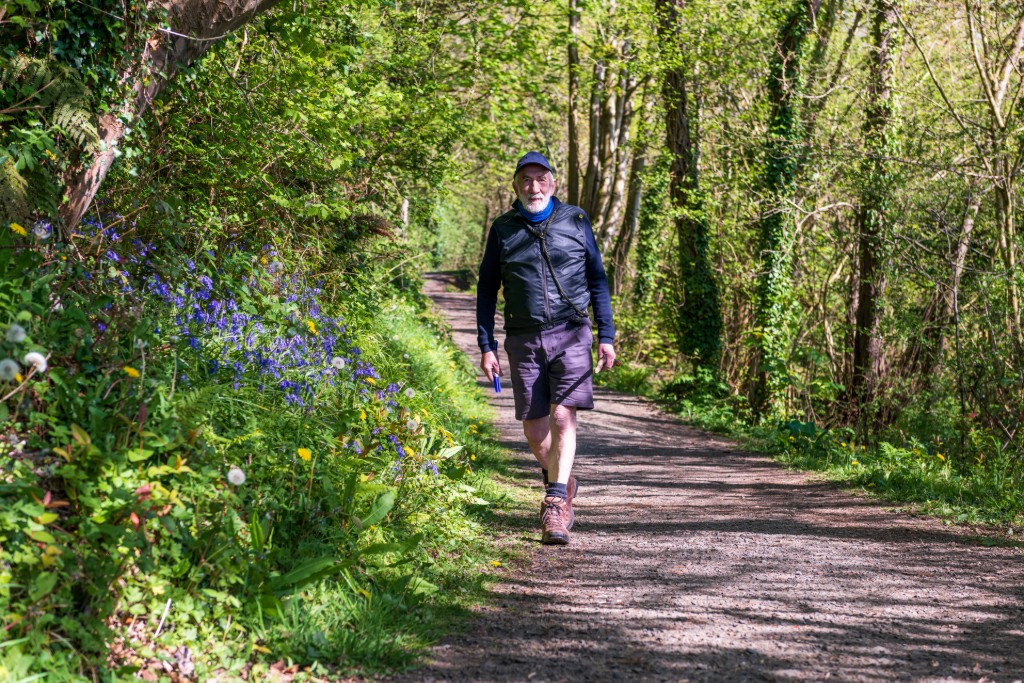
Author Derek Sinnamon at Mountsandel Wood, County Londonderry
My own woodland meanderings in Northern Ireland lead me to Coleraine’s broadleaf Mountsandel Wood just south along the River Bann from the beautiful north Antrim coastline. There I meet Derek Sinnamon, author of Reflections on the Bann, who has a special connection to these woods and the mysterious grass-shrouded earthwork fort at their heart.
He too has fond family memories of rolling painted Easter eggs down these hills, but more recently has become fascinated with the much older memories that these riverside slopes hold. The fort itself is unexcavated and the jury out as to whether it is the site of a 12th century Anglo-Norman “motte” or if it dates further back. Just behind the fort, however, is the site of a 1973 archaeological dig which found evidence of Ireland’s earliest known human settlement, dating back nearly 10,000 years.

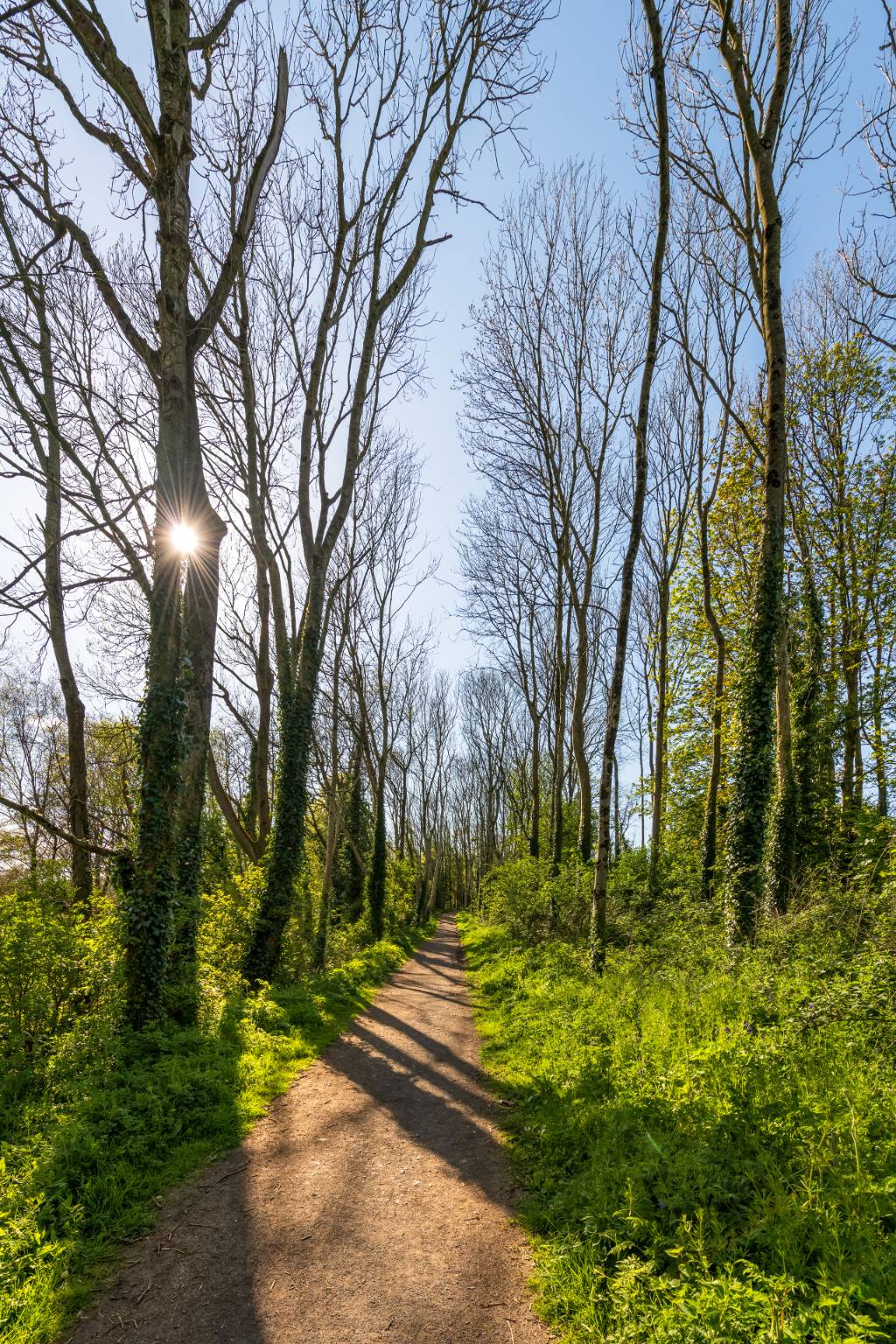
Mountsandel Wood, County Londonderry
We know this because, unlike the many stone instruments that were found here, remnants of organic matter that had been preserved in the low-acidity soil could be carbon dated. Remains of huts and their hearths scattered with fish bones and charred hazelnut shells hint at the life of the family of Mesolithic hunter-gatherers based in these wooded hills.
They would have chosen this site for its panoramic views across land and sea, and its abundant food sources: salmon and other fish from the tidal river below, eels making the last leg of their journey from the Sargasso Sea to Lough Neagh upriver of here, nuts and crab apples from the surrounding woods, and perhaps wood pigeon, hare or wild boar if they could catch them.


Mountsandel Fort, County Londonderry
I return to the fort alone later, and sit on the lip of the hill, watching herons swoop and gulls rush over the river below.
I listen to the forest life around me, and to life beyond that – the distant but distinct sound of tyres on tarmac, a hedge strimmer in sunshine, an airplane barrelling high – and wonder what sounds that Mesolithic family would have heard when all noise of modern man had been stripped out of the ether and all the natural-world sounds of 10,000 years ago were heightened. Presumably a hunter-gatherer knew how to properly listen to a forest.
A dream getaway
L-R: Luxury accommodation; outdoor bathing; private lodges; Burrenmore Nest, Binevenagh, County Londonderry
On my final evening, I take up residence in the understated luxury of Burrenmore Nest just north along the Atlantic coast at Downhill Woods, where you’ll find Ireland’s fattest Sitka spruce and the extraordinary Mussenden Temple and Downhill Demesne within a short stroll, and sandy strands just a short drive further. I catch the sun setting over Magilligan Point and Inishowen.
As dusk falls I soak in my own personal hot tub below one of four ultra-private lodges elevated in the evergreens: mine is the Peacock’s Roost, named after a family of peacocks who like to ascend into the tall trees around about now for nightly protection.
I switch off the stream of bubbles during most of my soak and take in the hush of the nearby cascade tumbling down rocks as my flighty iridescent-feathered neighbours throw the odd plaintive mewl my way. I sleep like a proverbial log, and as morning breaks, I open the windows wide to bathe in the dawn chorus from my comfortable bed. Never has a day extended me such a welcome. I rise to meet it, feeling truly fortified.





